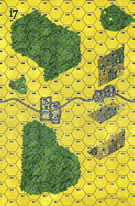|
|
|
Total |
| Side 1 |
0 |
| Draw |
0 |
| Side 2 |
0 |
|
Total |
| Side 1 |
0 |
| Draw |
0 |
| Side 2 |
0 |
|
Total |
| Side 1 |
0 |
| Draw |
0 |
| Side 2 |
0 |
|
| Overall Rating, 0 votes |
|---|
|
|
|
Scenario Rank:
of |
| Parent Game |
Secret Weapons |
| Historicity |
Alt-History |
| Date |
1945-08-01 |
| Start Time |
10:00 |
| Turn Count |
20 |
| Visibility |
Day |
| Counters |
75 |
| Net Morale |
0 |
| Net Initiative |
1 |
| Maps |
3: 15, 17, 18 |
| Layout Dimensions |
84 x 43 cm
33 x 17 in |
| Play Bounty |
205 |
| AAR Bounty |
223 |
| Total Plays |
0 |
| Total AARs |
0 |
|
Introduction
|
|
Throughout the Second World War, armies sought a cheap and effective counter to enemy armor. As tanks grew larger and better protected, the small unguided rockets like the American bazooka and German Panzerschrek became less effective. A guided missile with a larger warhead might give infantry the upper hand.
|
|
Conclusion
|
|
One of the logical problems with any scenario positing Nazi resistance past the summer of 1945 is the severe lack of manpower afflicting the German armies. No matter what new technology might be developed and placed in the hands of the soldiers, the fact remains that the number of those soldiers was rapidly declining. And those who remained were either too old or too young, and overwhelmingly unenthusiastic.
|
Display Relevant AFV Rules
| AFV Rules Pertaining to this Scenario's Order of Battle |
- Vulnerable to results on the Assault Combat Chart (7.25, 7.63, ACC), and may be attacked by Anti-Tank fire (11.2, DFT). Anti-Tank fire only affects the individual unit fired upon (7.62, 11.0).
- AFV's are activated by tank leaders (3.2, 3.3, 5.42, 6.8).
They may also be activated as part of an initial activating stack, but if activated in this way would need a tank
leader in order to carry out combat movement.
- AFV's do not block Direct Fire (10.1).
- Full-strength AFV's with "armor efficiency" may make two anti-tank (AT) fire attacks per turn
(either in their action segment or during opportunity fire) if they have AT fire values of 0 or more
(11.2).
- Each unit with an AT fire value of 2 or more may fire at targets at a distance of between 100% and 150% of its
printed AT range. It does so at half its AT fire value. (11.3)
- Efficient and non-efficient AFV's may conduct two opportunity fires per turn if using direct fire
(7.44, 7.64).
Units with both Direct and AT Fire values may use either type of fire in the same turn as their opportunity fire,
but not both (7.22, 13.0).
Units which can take opportunity fire twice per turn do not have to target the same unit both times (13.0).
- Demoralized AFV's are not required to flee from units that do not have AT fire values (14.3).
- Place a Wreck marker when an AFV is eliminated in a bridge or town hex (16.3).
- AFV's do not benefit from Entrenchments (16.42).
- AFV's may Dig In (16.2).
- Closed-top AFV's: Immune to M, M1 and M2 results on Direct and Bombardment Fire Tables. Do not take step losses from Direct or Bombardment Fire. If X or #X result on Fire Table, make M morale check instead (7.25, 7.41, 7.61, BT, DFT).
- Closed-top AFV's: Provide the +1 modifier on the Assault Table when combined with infantry. (Modifier only applies to Germans in all scenarios; Soviet Guards in scenarios taking place after 1942; Polish, US and Commonwealth in scenarios taking place after 1943.) (ACC)
- Tank: all are closed-top and provide the +1 Assault bonus, when applicable
|
Soviet Union Order of Battle
| 3 Errata Items |

|
The reduced direct fire value of the Heer HMG became 5-5 starting with Fall of France.
|

|
The movement allowance on the counters in Airborne is misprinted. It should be "3."
|

|
The reduced direct fire value in Kursk: Burning Tigers is 4-4.
|







 SeWp029
SeWp029 



















